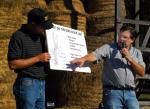COLUMBIA, Mo. – Beef producers take pride in their cattle. When replacing toxic-fescue pastures, they can take pride in grass, says an extension forage specialist.
Novel-endophyte fescues make cattle perform and look better, says Craig Roberts of the University of Missouri-Columbia.
Bad things happen when cattle graze toxic fescue. Shaggy hair looks bad, Roberts says. “Fescue cattle” retain their winter hair into summer. With new novel-endophyte fescues, cattle slick up in spring. That cuts heat stress.
There’s more than better hair, Roberts adds. Cattle gain more pounds per grazing day.
Ergovaline, a toxin found in Kentucky 31 fescue, causes many other faults. The toxin lowers reproduction and milking ability.
In winter, the toxin restricts blood flow to extremities. That causes frozen ears and feet. Frozen ears look bad while fescue foot can cause death.
A series of one-day schools, starting March 28 in Welch, Okla., will continue on into Missouri that week.
The schools, in their fourth year, explain toxic dangers of Kentucky 31 fescue. K-31 fescue is hardy and productive, making it the most used grass in Missouri and many states in the fescue belt.
Most important, the schools tell how to kill old stands of fescue and replace them with healthy versions, Roberts says.
The schools held by the Alliance for Grassland Renewal are taught by MU Extension, USDA Natural Resources Conservation Service, seed company and farmer representatives.
K-31 fescue was widely seeded before the toxic effects were noticed. An endophyte fungus growing between cell walls makes the toxin.
Now, seed companies offer several novel-endophyte fescue varieties. Plant breeders found natural occurring nontoxic endophytes. Those were bred into the new seeds.
Pasture renovation brings economic returns for beef producers. Calves gain faster and are healthier.
“Payback is vital,” Roberts said. “But pride in cattle and grass also count in the pleasure of beef farming.”
For years, producers accepted the downside of toxic fescue. They worked around it, Roberts says.
“Novel endophytes are like a cure for a disease,” he says. “No longer will we treat symptoms. We have the cure.
Read more http://extension.missouri.edu/news/DisplayStory.aspx?N=2761





